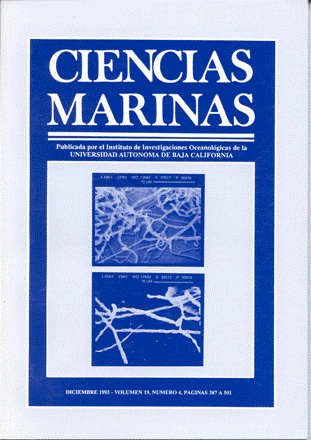Relationship between surface chlorophyll and chlorophyll in the euphotic zone of the Gulf of California: possible application to estimate primary production with data obtained by remote sensors
Main Article Content
Abstract
The vertical distribution of pigments (chlorophyll a) in the study area showed maximum surface chlorophyll to the north of line 240, subsurface and deep chlorophyll maxima to the South of line 320 and both kinds of distribution between lines 240 and 320. Surface chlorophyll was positively correlated with integrated chlorophyll within the euphotic zone (r = 0.61, p < 0.001). We found a higher linear correlation between the chlorophyll concentration presumably measured by remote sensing and the integrated chlorophyll (r = 0.79, p < 0.001). The estimation of integrated chlorophyll in the euphotic zone from surface chlorophyll was complicated because of the variability of the vertical profiles of pigments for this season. Therefore, we propose a mean normalized profile of pigments for the use of primary production models based on light and phytoplankton biomass. From the mean normalized chlorophyll profile, during winter the Gulf of California can be classified as a mesotrophic region, with a not very prominent subsurface chlorophyll maximun.
Downloads
Article Details
This is an open access article distributed under a Creative Commons Attribution 4.0 License, which allows you to share and adapt the work, as long as you give appropriate credit to the original author(s) and the source, provide a link to the Creative Commons license, and indicate if changes were made. Figures, tables and other elements in the article are included in the article’s CC BY 4.0 license, unless otherwise indicated. The journal title is protected by copyrights and not subject to this license. Full license deed can be viewed here.

